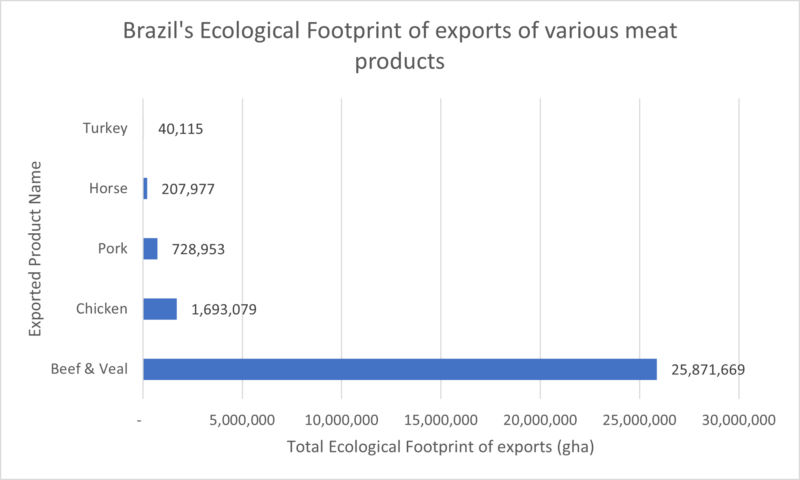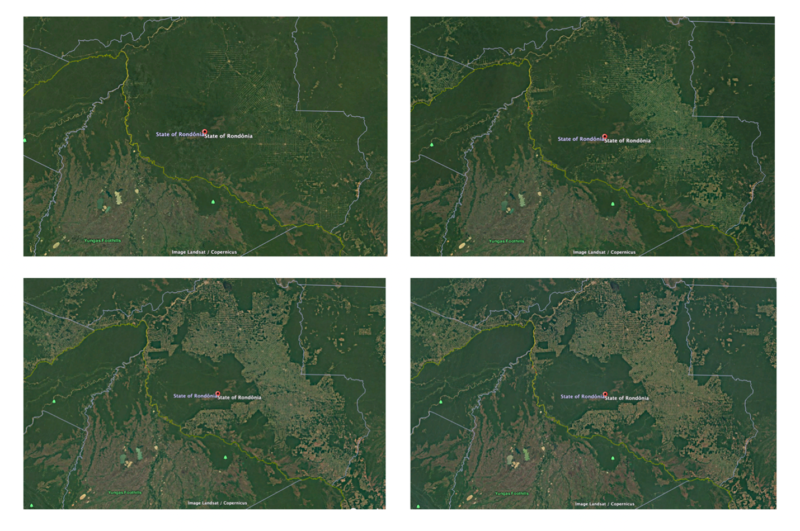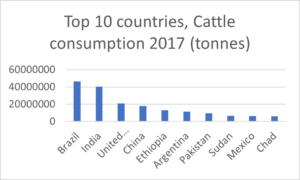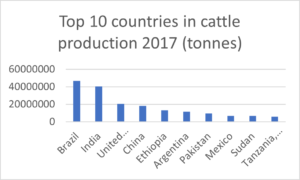How Much Cattle How Much Beef Does Brazil Produce Each Day
This blog postal service is part of the Ecobytes series, where nosotros explore interesting topics from Ecological Footprint and biocapacity data conducted and authored by our wonderful interns. This week, Camille Kawawa-Beaudan dives into information on Brazilian beef. Camille, a recent graduate of UC Berkeley, is passionate about sustainability and creating system-wide changes to create a healthy world for current and future generations. She currently works at a company focused on removing single utilise plastic from households' groceries.
Reducing meat consumption is often presented as one of the most sustainable actions an individual tin make. This has go a common talking signal in environmental media, and these discussions have prompted me to recall more about some of my dietary choices. Only it has also fabricated me curious to learn more about the data that backs these claims: how many cattle are raised around the world annually to feed everyone, and how does this product touch on the surround of the producing countries?
In 2017, 64 meg tonnes of beef was produced globally. Brazil is the world's largest producer of cattle besides every bit the largest beef exporter, providing "shut to 20 percent of total global beef products" according to the USDA's Environmental Enquiry Service.one UNFAO'southward data on livestock product shows that Brazil had a stock of 215 million cattle in 2017.2 In that same year, nine.5 one thousand thousand tonnes of beef were produced, and ane million tonnes of beef and veal was exported.
You might be asking yourself, "So what? What do all these numbers mean? And what does it hateful for Brazil'due south environment?" I besides asked myself these questions, because frankly, I notice information technology hard to empathize with numbers unless they're contextualized.
The concepts of biocapacity and global hectares are powerful tools to plant the necessary context for these numbers. Biocapacity is the amount of biologically productive land (or water) available for regeneration, including crop land, forest land, and grazing land, among others. This total area is averaged to create a standard unit of measurement chosen a global hectare. As we go on to demand more from our natural environments, consume more than products, increase our population size, and degrade our ecosystems, we deplete the ability of our bioproductive lands (and water) to regenerate. While nosotros may be able to survive while running a biocapacity deficit in the brusque term, the long-term implications of depletion are disastrous. For example, by clearing the most biodiverse woods in the world to brand space for cattle grazing, nosotros increment meat supplies in the short run, simply we lose countless species from habitat loss, reduce potential oxygen production and carbon drawdown that the cleared wood could have provided, and destroy the homes and bequeathed country of ethnic communities.
Love information? Subscribe to our newsletter!
A significant portion of Brazil's beef is pasture-raised, simply while this might sound like a win for environmentally conscious shoppers, this pasture-fed beef comes at a steep price. Between 2015 and 2017, 210,000 acres of deforestation in Brazil were linked to Brazilian beef exports.3 The report is published by Trase, a deforestation tracking platform created by the Stockholm Surround Institute and Global Awning. Betwixt June 2016 and July 2017, former President Trump temporarily lifted a ban on fresh meat imports. During those same dates, Amazon deforestation spiked massively as fresh meat imports to the US also spiked in Brazil.4
The cleared land is used for grazing cattle to produce the beefiness products that are exported worldwide. Global Footprint Network's National Footprint and Biocapacity Accounts testify that in 2017, Brazil's Ecological Footprint of export (EFe) of cattle meat, beefiness, and veal was over 25.eight meg global hectares. The Ecological Footprint of exports represents the biocapacity required to produce the appurtenances being exported. To put that into context, the biocapacity used for the export of cattle in Brazil solitary was larger than Ireland and Belgium'southward total biocapacity combined in 2017.

What does this deforestation mean for Brazil? Global Footprint Network'southward data shows that Brazil continues to have a biocapacity reserve of 5.8 global hectares per person. This means that Brazil's residents are living within the ways of the natural resources within its borders. However, this big biocapacity reserve is due to the fact that Brazil is steward to the most biodiverse state in the world. Brazilians on boilerplate have an Ecological Footprint of 2.eight global hectares per person. Put another way, to regenerate all the resource that Brazilians demand in a year, we would still demand ane.5 Earths.
Brazil's biocapacity reserve is literally burning at this moment. Much of their biocapacity resides within the Amazon forest, which is being actively burned downwards to make room for cattle grazing and farming, mining and wood extraction. five While deforestation figures vary, Mongabay'south database on Amazon deforestation shows that in 2017, 2,682 foursquare miles of the rainforest were chopped down.6 The data is pooled from Brazil's National Institute for Space Research and Imazon, a Brazilian NGO.

Global Footprint Network'southward public data shows that Brazil's biocapacity reserve has been declining at an exponential rate since 1961, the earliest year of data drove past the organization.seven In 1961, the country had a biocapacity reserve of 20.five global hectares per person. In 2017, the biocapacity reserve was v.8 global hectares per person.
This biocapacity decline tin can be reversed. Brazil prepare some of the nigh ambitious targets for their Nationally Determined Contributions to the Paris Understanding, which was signed in 2015 and outlines national commitments to reducing their impact on climate change to keep global warming to within one.five degrees Celsius of pre-Industrial Revolution levels. Brazil reaffirmed their delivery to reducing total net greenhouse gas emissions by 37% in 2025 and reducing emissions by 43% in 2030, based on their 2005 emissions.8 According to the Brazilian Roundtable on Sustainable Livestock, i way the land is tackling this goal is past reducing the amount of pasture land and concentrating livestock grazing.ix Equally global citizens, one way we can assistance Brazil accomplish their goals is to be more conscious of the beef we eat. Choosing to consume beef sourced elsewhere would reduce demand for Brazilian beefiness, thus reducing the need for more than grazing land. Another pick would be to reduce the corporeality of meat you eat in a week. And maybe the strongest style to help reduce the environmental footprint of beef production around the earth is to brainwash others on the bear on of their repast decisions, giving them the ability to make more informed choices.


[i] https://world wide web.ers.usda.gov/bister-waves/2019/july/brazil-once-again-becomes-the-earth-due south-largest-beefiness-exporter
[two] Brazil Workbook License (available for purchase hither)
[3] http://resources.trase.globe/documents/infobriefs/TraseInfobrief8En.pdf
[4] https://news.mongabay.com/2019/10/brazilian-beef-industry-plays-outsized-office-in-tropical-carbon-emissions-written report
[5] https://www.cnn.com/2019/11/19/americas/brazil-deforestation-amazon-2019-trnd/alphabetize.html
[6] https://rainforests.mongabay.com/amazon/deforestation-rate.html
[7] https://data.footprintnetwork.org
[viii] https://world wide web.gov.br/mre/en/contact-us/press-area/press-releases/brazil-submits-its-nationally-determined-contribution-under-the-paris-agreement
[ix] https://world wide web.inputbrasil.org/wp-content/uploads/2016/x/GTPS_BRAZILIAN-LIVESTOCK-OVERVIEW_v3.pdf
Source: https://www.footprintnetwork.org/2021/06/11/ecobytes-beef-and-brazils-declining-biocapacity/
Belum ada Komentar untuk "How Much Cattle How Much Beef Does Brazil Produce Each Day"
Posting Komentar